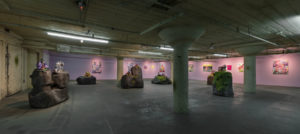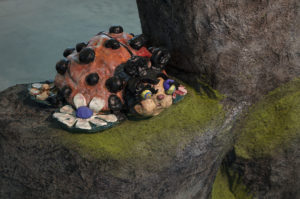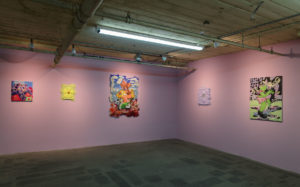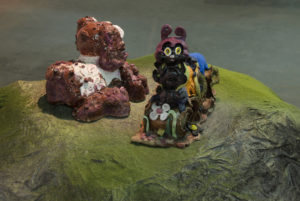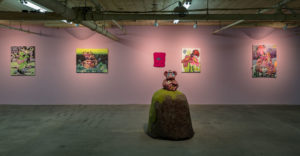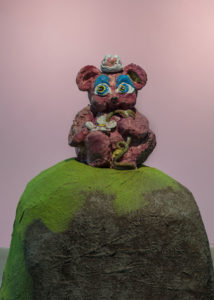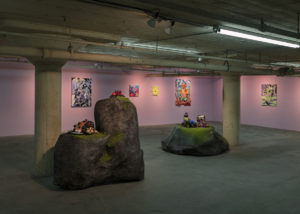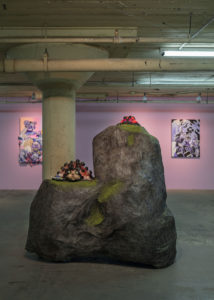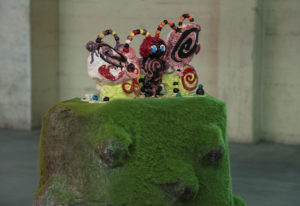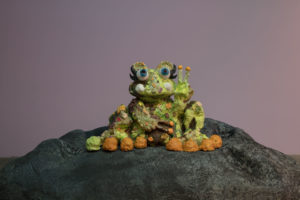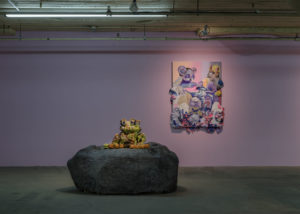Alake Shilling: Monsoon Lagoon
- Interview with Alake Shilling by Anthony Valdez (en | es)
January, 2018
Conducted on the occasion of the exhibition “Alake Shilling: Monsoon Lagoon” at 356 Mission
Anthony Valdez: What’s the most annoying question anybody has ever asked you about your art?
Alake Shilling: Well, if I think about it I guess I’d have to say that question is, “Do you do drugs?” Basically, the question feels like I must do drugs to make these paintings, which isn’t true.
AV: Why do you think people ask you if you do drugs to make these paintings?
AS: Honestly, the question used to confuse me so much, and I wasn’t really sure how to respond. But, I guess it’s because the colors and lines I use and their association with acid trips. But I really don’t like stoner art. I think it’s really ugly typically. Do you know what I mean?
AV: Yeah.
AS: I don’t always like the association but I do lean towards trippy wavy lines. I would associate that more with Optical Art from the 60s.
AV: Yeah, but the association makes sense because the late 60s/early 70s is when acid and stoner culture first trended and Op-Art was a thing, I think people give drug culture that aesthetic because they both became visible in pop-culture at the same time.
AS: Makes sense.
AV: I remember you told me a time when somebody asked you that question and your response was great.
AS: Yeah, they asked, “How can you make this and not be high?” and I said, “It’s called an imagination, duh!”
AV: Well, I think some people feel that if they take drugs they can unlock their imagination or whatever, but you definitely don’t need that.
AS: I feel like I try my best to stay in touch with reality, so I can feel and sense the world around me it informs my work. If I was under that kind of influence it would dull my senses too much, and I wouldn’t be able to make anything.
AV: I see that there are a few recurring animals in the work. There are two frog paintings and some bears. Do you feel like these animals are like Disney characters in that they exist in the same world?
AS: There are many different characters that strike my fancy. But for this show, I did my best to stick to a select group of favorites, the bear, and the frog mostly. But all of my characters exist in the same wonky world. But I’m not sure if my characters exist to each other, or if they necessarily interact with each other. Hmmm…I think they may wander, travel and encounter each other. In all reality, each animal represents a feeling, the personification of an emotion, not necessarily a character.
AV: Where cartoon characters are designed to comfort people or make kids feel excited, these characters seem like they’re the ones that need comforting…
AS: Oh, yeah. That’s the attention grabber I suppose. I want people to empathize with the characters, to draw everyone into the experience through color and texture. Hopefully, once you’re transported into this world there is more there than meets the eye. Each character should embody: distress, sadness, hysteria, insanity, violence – something that makes people think “Maybe I should sit still and listen to what’s happening.”
AV: So it’s important that the paintings embody a particular emotion?
AS: Yeah, but I want it to be subtle. Everything should also have a sensual layer too, but it’s not overt and it doesn’t slap you in the face. It’s more like “Oh, I could imagine running my hand across that frog’s legs because it’s so smooth and creamy…” something like that! There are so many lumps that you just want to touch them and hug them and just want to climb inside those lumpy creatures and just become one with them!”
AV: I can see that some paintings and sculptures range from flat surfaces to lumpier and chunky textures. Is that meant to evoke this kind of feeling?
AS: Yeah! People can have a great emotional attachment to texture. I have a fixation with textures. They make me excited, especially when I encounter a certain consistency such as hair or the feeling of petting a cat. Touching things take you back to times when you like a certain blanket or things like that.
AV: I know that Lisa Frank had a big influence on you, but those characters are always so smooth and happy and inviting and designed to comfort the kids who are holding that backpack or folder while looking cool. But not having that in the work is what makes this ‘adult.’ This frog seems like they’re really happy on first glance…but actually looks really detached while stepping on a butterfly!
AS: Well, there is definitely a storyline unfolding. And I mean, every character can’t always have the same disposition all the time. That would make the character ornamental…that wouldn’t mean anything to me I guess. It’s very simple, that’s all!
AV: Is there any one character you think represents you the most? Or is there a character someone else has said you’re most like?
AS: Oh yes! The bear I like to paint…my mother says it reminds her of me because bear and I share similar personality traits. For example, the bear has a round tummy. It looks exactly like my tummy, which I didn’t notice until she pointed that out. The disposition, the expressions in the eyes and the way the hands are positioned; Sometimes she says that it’s how I sit and things like that. Who knows?
AV: I can see that! When the bear smiles it has the same eyebrows as you do! Like how your eyebrows go up in the middle when you smile!
AS: That’s so funny! Because the resemblance is unintentional. I guess every artist includes a piece of themselves in their work.
AV: There is emotion in the work, but there is also a kind of aloofness to the characters represented in it, or how they act towards each other, that also reminds me of you a bit. Do you see yourself as an aloof person? How do you think that relates to the work?
AS: Well, I think that the work is a way for me to really articulate all the emotions. I am a really emotional person, but you would never know because of my natural aloofness. I am in touch with my emotions, but I am not very vocal about things like that – that’s just who I am. But, through my work I can be as loud as I want and feel how I want; I guess that’s why the characters seem a little off in some way. I guess I am sorting out different feelings that I have inside, that I would never discuss out loud. There are a quite a few violent acts but it’s kind of subtle, it’s…
AV: All very cute…
AS: I don’t know! I’d never paint a character with its head cut off. I feel like I would never go that far but I would paint a frog stepping on a butterfly. Because the butterfly is still alive, it’s just kind of trapped under a rock. So that’s a fun way to articulate that feeling. I like subtle things.
AV: It reminds me of a show I saw the other day about this theorist named Sianne Ngai. She says that instead of using traditional aesthetic categories like the beautiful and the sublime, we use the zany, the cute, and the interesting. To her, they ‘dominate’ the look of our culture’s art and commodities as well as how we talk about the feelings we get from experiencing the world and its products. These newer categories also express conflicting feelings related to how we work, exchange, and consume. Like, the zany refers to a style of performing, or affective labor that is bound up with production and engages our playfulness AND our sense of desperation. The interesting is tied to easy access to information and debates that inspire us but can also be dry. And the cute as aesthetic product brings out feelings of tenderness and aggression simultaneously. Not to go on but this reminded me of you fully. Your sort of affected, intentional, but sincere persona; how you consume and even how people have ‘discovered’ your work and have consumed it, and the crazy cute but emotional and sometimes frightening work you make.
AS: Oh my gosh, that really describes me! I do my best to relate to people using cute imagery. Because cute is cute, and how can you resist cute? I mean it’s biological, like looking at babies or animals. When people see big eyes and a round head and a tummy, they’re drawn to these features, and it’s human nature to want to see cute things but then to show other emotions attached to these images once you really notice what is going on, that’s one of the reasons why I think cute is so important.
AV: And it ties back into wanting to comfort the characters but also kind of being comforted by these characters.
AS: Exactly.
AV: Do you like the idea of viewers identifying themselves and others to your characters? I can really relate to the frog.
AS: Yeah I think that’s really cool, I really strive for my paintings to be relatable, for everybody. Maybe viewers can be transported to another time in their life, even if it’s not a happy time. I feel like you can be reminiscent of yourself in some way, if that makes sense. I want it to be multifaceted.
AV: Some people have thrown around the outsider art label when encountering your work. Do you feel that’s accurate or relevant? Why do you think the association?
AS: I think probably because of the craft-like element and the kitsch elements, probably more of the crafty element. I thought outsider art basically meant untrained or not accepted into an institution or by an institution. But I wouldn’t totally categorize myself as an outsider artist. I do like the aesthetic of outsider art and crafts. I like crafts and I try to include it in my work because I find it interesting and that’s how I started making art – it was through crafts.
AV: When did you start making crafts which lead to this practice?
AS: Oh yeah, well much of my art has to do with my mom. She didn’t have daycare when I was younger so she took me to the university with her, gave me coloring pencils and paper so I wouldn’t make a fuss in class. After hours of class, she discovered drawing and coloring really kept me entertained. I was really focused on drawing, and she was very impressed with what I had made by the end of class. That was the beginning of my fascination with art. She also used to work at the YMCA, and there was a lot of craft making going on there like ceramics, painting, and drawing. I really enjoyed activities like that. Basically, I feel like my love of art stems from my mother wanting me to create something with my mind when she was in school and at work. She wanted me to be working too and it worked out I think.
AV: What other things from your childhood or past have influenced you? I think you mentioned “Monsoon Lagoon”, the title of the show, was the name of a water park you used to go to?
AS: Yeah, I used to be obsessed with going to Monsoon Lagoon, a cute little water park we went to all the time when I was little. I have a distinct memory of a volcano gushing water. I loved being covered in that water – it was just sublime!
AV: What’s a color you like a lot these days?
AS: Pink.
AV: And you’re using a lot of glitter in these works.
AS: I know glitter is considered tacky and a lot of people don’t like it, but I like it and that’s why I use it. I only really use one type of glitter and that’s the clear glitter because it has a twinge of class.
AV: Whose work do you really hate right now?
AS: That’s a BAD question!
AV: You don’t have to answer; I was kind of kidding.
AS: Well, there is one artist whose art might be viewed as providing insightful commentary on black culture but in my opinion, the titles aligned with the art emerge as a bit sensational; I don’t get the impression the artist is very thoughtful about context or the world in within which their art is embedded. My perspective is that the artist is striving to shock people through their commentary, but yeah, I don’t know, I don’t like it.
AV: They’re trying to be specifically political or something, but they’re cheapening the conversation. I do think everything is political in some way. Do you think people could call your art political? And do you like that?
AS: Yeah you can associate any meaning to art that you want, and that’s great. There are some political undertones, but I am not interested in making a political commentary. To be an artist who is also black and a woman is political commentary enough. It’s just so boring because my whole life is political commentary, to have to discuss that in art too, which is something I enjoy and something I feel like should be a release for me?! Why should I have to comment on what it’s like to be black or a woman? I mean, if you don’t know, that’s not my problem!
AV: I agree; we shouldn’t have to take on that emotional labor. It’s just hard not to think about it when you’re a person of color, we get reminders every day.
AS: That’s true. I don’t know if it’s just me being insecure. But I do feel sometimes that if people see me, or meet me before they see my work then that influences how they view my work.
AV: You shouldn’t have to feel like that. Well, let’s end on a different note, what artists do you like?
AS: Oh, I like lots of artists, all the Chicago imagists, those are my favorite. I like Peter Saul. I like Rebecca Morris and Laura Owens too. I like mostly fun, bright colors and characters. There is such a long list but that’s what comes to my mind right away.
AV: What artist would you like to meet?
AS: Kanye West, he seems just so crazy! I want to pick his brain and see what’s going on in there!
Anthony Valdez is the Manager of Special Projects at 356 Mission
Entrevista con Alake Shilling par Anthony Valdez (en | es)Entrevista con Alake Shilling par Anthony Valdez con ocasión de
Alake Shilling: Monsoon Lagoon/La laguna del Monzón
23 de febrero – 29 de abril, 2018
en 356 S. Mission RoadAnthony Valdez: ¿Cuál es la pregunta más irritante que te han hecho jamás sobre tu obra?
Alake Shilling: Bueno, si lo pienso supongo que tendría que decir que la pregunta es “¿Tomas drogas?” Básicamente, la pregunta me hace sentir que tendría que drogarme para producir estas obras, lo que no es verdad.
AV: ¿Por qué piensas que la gente te pregunta si te drogas para hacer estos cuadros?
AS: Honestamente, la pregunta solía desorientarme mucho, y no estaba muy segura de cómo contestar. Pero supongo que por los colores y las líneas que uso y su asociación con los viajes de ácido. No me gusta el arte de los mariguanos. Creo que por lo general es muy fea, ¿me entiendes?
AV: Sí.
AS: Por lo general no me gusta esa asociación, pero es verdad que me inclino hacia las líneas onduladas algo tripy. Yo lo relacionaría más con el arte óptico de los años 60.
AV: Si, pero la asociación tiene sentido porque a fines de los 60 y principios de los 70 fue cuando el ácido y la cultura de las drogas se pusieron de moda por primera vez, y el Op-art también lo estaba. Creo que se asoció esa estética a la cultura de las drogas porque las dos aparecieron al mismo tiempo en la cultura popular
AS: Eso tiene sentido.
AV: Recuerdo que me contaste que una vez alguien te hizo esa pregunta y tu respuesta fue genial.
AS: Sí, me preguntaron “¿Cómo puedes hacer esto y no estar colocada?” Y le dije: “Se llama imaginación, ¿va?”
AV: Bueno, me parece que hay gente que piensa que si toma drogas puede abrir su imaginación o lo que sea, pero desde luego, a ti, eso no te hace falta.
AS: Siento que trato al máximo de mantenerme en contacto con la realidad; así puedo sentir el mundo que me rodea, que informa mi obra. Si estuviera bajo un efecto así me afectaría demasiado los sentidos y no sería capaz de hacer nada.
AV: Veo que en tu trabajo hay algunos animales recurrentes. Hay dos cuadros de ranas y algunos de osos. ¿Te parece que estos animales son como personajes de Disney, que existen en el mismo mundo?
AS: Hay muchos tipos de personajes que me atraen. Pero para esta exposición traté de limitarme a un grupo selecto de mis favoritos: el oso y la rana sobre todo. Pero todos mis personajes existen en el mismo mundo extraño. No estoy segura que los personajes existan unos para otros, ni si interactúan entre ellos. Hmmmm…. me parece que tal vez deambulen, viajen, y se encuentren entre sí. En realidad, cada animal representa un sentimiento, la personificación de una emoción, no necesariamente un personaje.
AV: Mientras que los personajes de las historietas están diseñados para reconfortar a la gente, para hacer que los niños se entusiasmen, parece que estos personajes sean los que necesitan ser reconfortados…
AS: Oh, sí. Supongo que eso es lo que llama la atención. Quiero que la gente sienta empatía hacia los personajes, llevar a todos a tener una experiencia a través del color y la textura. Espero que una vez que te dejas llevar a ese mundo encontrarás algo más allá de lo visible. Cada personaje debería encarnar sentimientos de alarma, tristeza, histeria, locura, violencia – algo que haga que la gente piense: “quizás debería sentarme y escuchar lo que está pasando”.
AV: ¿Entonces, es importante que los cuadros representen algún tipo de emoción?
AS: Sí, pero quiero que sea sutil. Todo debería también tener un elemento sensual, pero no es evidente, no te da en la cara. Es más bien como “Oh, me puedo imaginar pasando la mano sobre las patas de esa rana porque son tan suaves y cremosas…” Algo así. Hay tantos bultos que quieres tocarlos y los quieres abrazar y saltar sobre esas criaturas bultosas y aunarte a ellas.
AV: Veo que algunos cuadros y esculturas van de la superficie plana a texturas más abultadas y espesas. ¿Eso quiere evocar ese tipo de sentimiento?
AS: ¡Sí! La gente puede tener un gran apego emocional hacia las texturas. Yo tengo una fijación con las texturas. Me entusiasman, sobre todo cuando encuentro cierta consistencia, como el cabello o la sensación de acariciar un gato. Tocar las cosas te transporta a una época en la que tenías cierta sábana, o algo así.
AV: Sé que Lisa Frank es una influencia muy importante en tu obra, pero sus personajes siempre son suaves y felices y atractivos y diseñados para reconfortar a los niños cuando llevan la mochila o la carpeta, al mismo tiempo que se ven chidos. Pero el que eso no esté en tu obra es lo que la hace “adulta”. Esta rana parece, a primera vista, que no es muy feliz… pero en realidad se ve muy desconectada mientras pisa una mariposa.
AS: Bueno, desde luego, se está desarrollando una historia. Quiero decir, cada personaje no puede siempre tener la misma disposición. Eso haría que el personaje fuera ornamental… supongo que para mí no querría decir nada. Es muy sencillo, eso es todo.
AV: ¿Crees que hay algún personaje que te represente más que otros? ¿O hay algún personaje al que alguien haya dicho que te pareces más?
AS: ¡Claro! El oso que me gusta dibujar… mi madre dice que le recuerda a mí porque el oso y yo tenemos algunos rasgos similares de personalidad. Por ejemplo, el oso tiene una barriga redonda. Es exactamente igual que mi barriga, lo que yo no había notado hasta que ella lo mencionó. La disposición, la expresión de los ojos, la forma en la que están colocadas las manos, a veces dice que es igual a cómo yo me siento y esas cosas. Quién sabe.
AV: ¡Sí que lo veo! ¡Cuando el oso sonríe tiene las mismas cejas que tú! En la manera en la que te suben las cejas en el medio cuando sonríes.
AS: ¡Qué divertido! Porque el parecido no es intencional. Supongo que todos los artistas ponen algo de sí mismos en su obra.
AV: Hay emoción en la obra, pero también hay una especie de distancia en los personajes que se representan, o en cómo actúan hacia los otros; eso también me recuerda un poco a ti. ¿Te ves cómo una persona distante, desprendida? ¿Cómo te parece que se asocia eso con tu trabajo?
AS: Bueno, me parece que la obra es una forma de articular todas las emociones. Soy una persona muy emotiva, pero nunca lo adivinarías porque soy bastante distante. Estoy en contacto con mis emociones, pero no hablo mucho de eso –no soy así. Pero a través de mi obra puedo gritar todo lo que quiera y sentirme como me da la gana; supongo que es por eso que los personajes parecen un poco raros. Supongo que estoy explorando emociones que llevo dentro y que nunca mencionaría en voz alta. Hay bastantes actos violentos, pero son bastante sutiles, es…
AV: Todo muy dulce…
AS: No sé. Nunca pintaría un personaje decapitado. Siento que nunca iría tan lejos, pero pintaría una rana pisando una mariposa. Porque la mariposa todavía está viva, está como atrapada debajo de una piedra. Es una manera divertida de articular ese sentimiento. Me gustan las cosas sutiles.
AV: Me recuerda a una exposición que vi el otro día sobre una teórica social que se llama Sianne Ngai. Dice que en vez de usar categorías estéticas tradicionales como lo hermoso y lo sublime, usamos ridículo, lindo, e interesante. Según ella, dominan la forma del arte de nuestra cultura y los objetos de consumo, igual que cómo hablamos de las emociones que sentimos al experimentar el mundo y sus productos. Además, estas nuevas categorías expresan emociones encontradas relacionadas con la manera en la que trabajamos, nos relacionamos y consumimos. Así, lo ridículo se refiere a una forma de actuar, una labor afectiva que va relaciona con la producción y que incorpora lo lúdico además de nuestro sentimiento de desesperación. Lo interesante se asocia al fácil acceso a la información y a los debates que nos hacen sentir inspirados pero que también pueden resultar muy áridos. Y lo lindo como producto estético nos despierta al mismo tiempo sentimientos de ternura y agresión. No quiero extenderme en esto, pero me recordó totalmente a ti. Tu persona afectada, intencional pero sincera, la manera en la que consumes y hasta la manera en la que la gente ha “descubierto” tu obra y la ha consumido, y el trabajo locamente lindo, pero emotivo y a veces aterrador que produces.
AS: ¡Ay Dios! ¡Eso sí me describe! Me esfuerzo por relacionarme con la gente usando imágenes lindas. Porque lo lindo es lindo, y ¿cómo puedes resistirte a la lindura? Quiero decir, es biológico, como mirar bebés o animales. Cuando la gente ve ojos grandes y cabezas redondas y una barriga, se siente atraída a esas características, y no es parte de la naturaleza humana querer ver cosas lindas y luego mostrar otras emociones que van ligadas a esas imágenes una vez que te das cuenta de lo que verdaderamente está pasando. Ese es uno de los motivos porque pienso que “lindo” es tan importante.
AV: Y esto nos devuelve a querer reconfortar a los personajes, pero también a ser un poco reconfortado por los personajes.
AS: Exacto.
AV: ¿Te gusta la idea de que el público se identifique e identifique a otros con tus personajes? Yo me identifico mucho con la rana.
AS: Sí, creo que eso es muy chido. Trato de que mis cuadros se presten a esa identificación, para todo el mundo. Tal vez el público pueda sentirse transportado a otro momento de su vida, aunque no sea un momento feliz. Siento que de algún modo puedes hacerte recordar a ti mismo, si tiene sentido. Quiero que sea polifacético.
AV: Hay gente que ha usado la categoría de arte outsider al enfrentar tu obra. ¿Te parece adecuado o importante? ¿A qué crees que se debe la asociación?
AS: Creo que tal vez por el elemento artesanal y los elementos kitsch, seguramente más por lo artesanal. Yo pensaba que el arte outsider era básicamente un arte de gente sin preparación o que no era aceptada por una institución o para una institución. Pero yo no me categorizaría como una artista outsider. Me gusta la estética del arte outsider y de lo artesanal. Me gusta lo artesanal y trato de incluirlo en mi propia obra porque me parece interesante y es cómo empecé a hacer arte –a través de la artesanía.
AV: ¿Cuándo empezaste a crear artesanías que te llevaron a esta práctica?
AS: Ah, sí. Mucha de mi obra tiene que ver con mi mamá. No tenía una guardería cuando yo era pequeña, así que me llevaba con ella a la universidad, me daba lápices de colores y papel para que me estuviera quieta en clase. Fuera de las horas de clase se dio cuenta que dibujar y colorear me mantenían entretenida. Y cuando dibujaba estaba muy enfocada, y ella siempre quedaba muy impresionada con lo que yo hacía durante la clase. Ese fue el inicio de mi fascinación con el arte. Además, ella trabajaba en el YMCA y ahí había muchas actividades de tipo artesanal como cerámica, pintura y dibujo. Yo disfrutaba mucho de esas actividades. Básicamente, siento que mi amor pro el arte surge del que mi madre quisiera que hiciera algo con mi mente mientras ella estaba en clase o en el trabajo. Quería que yo también trabajara y creo que funcionó.
AV: ¿Qué otras cosas de tu infancia o tu pasado te han influido? Creo que mencionaste que “La laguna del Monzón”, el título de la exposición, era el nombre del parque al que ibas?
AS: Ah, sí, estaba obsesionada con ir a “La laguna del Monzón”, un parquecito acuático al que iba siempre cuando era pequeña. Tengo un recuerdo muy claro de un volcán que echaba agua. Me encantaba estar cubierta de agua. ¡Era, sencillamente, sublime!
AV: ¿Cual sería un color que te gusta mucho hoy en día?
AS: El rosa
AV: Y estás usando mucha purpurina en estas obras.
AS: Sé que la purpurina se considera algo naco y a mucha gente no le gusta, pero a mí me gusta y por eso la uso. En realidad, solo uso un tipo de purpurina, la transparente, porque tiene un toque de clase.
AV: ¿Cuál es la obra que más odias ahorita?
AS: ¡Esa es una pregunta MALA!
AV: No tienes que responder. Era un poco en broma.
AS: Bueno, hay un artista cuya obra se podría considerar un comentario incisivo sobre la cultura negra de hoy, pero en mi opinión los títulos que da a las obras son algo sensacionalistas. No me da la impresión de que el artista sea muy considerado con su contexto o con el mundo en el que está incrustada su obra. Mi opinión es que el artista quiere impactar a la gente a través de su comentario, pero sí, no sé, no me gusta.
AV: Tratan de ser políticos específicamente sobre algo, pero están abaratando el diálogo. Creo que de alguna manera todo es político. ¿Crees que la gente podría decir que tu arte es político? ¿Te gusta eso?
AS: Sí, puedes darle al arte cualquier significado que quieras, y eso está muy bien. Hay algunos tonos políticos, pero no me interesa hacer comentario político. Ser artista y además ser negra y mujer es suficiente comentario político. Resulta muy aburrido porque toda mi vida es comentario político ¿Tengo que abordar eso también en el arte, que es algo que disfruto y que siento que para mí debería ser una liberación? ¿Por qué tengo que comentar sobre cómo es ser negra o mujer? Digo, sí tú no lo sabes no es mi problema.
AV: Estoy de acuerdo; no deberíamos tener que acarrear esa tarea emocional. Pero es difícil no pensarlo cuando eres una persona de color; nos lo recuerdan todos los días.
AS: Es cierto. No sé si es que yo me siento insegura. Pero a veces sí siento que si la gente me ve, o me conoce antes de ver mi obra, que eso influye en la manera en la que miran mi trabajo.
AV: No deberías tener que sentirte así. Bueno, terminemos en otra nota. ¿Qué artistas te gustan?
AS: Oh, me gustan muchos artistas. Todos los imaginistas de Chicago, esos son mis favoritos. Me gusta Peter Saul; me gusta Rebecca Morris y también Laura Owens. Me gustan sobre todo los colores y los personajes divertidos y brillantes. Es una lista muy larga, pero eso es lo que se me ocurre ahorita.
AV: ¿A qué artista te gustaría conocer?
AS: Kanye West, ¡Parece tan loco! ¡Quiero interrogarlo y ver qué pasa en su cabeza!
- Select ReviewsAll of these works seem to be dabbling with each character and formulating various ideas about them. There was a wildly popular line of school supplies decorated with garish colors and stylized cartoon characters and the artist wanted to create his own language using the same formula. Shilling’s chose to depict cute animals not just because she liked them, but because he found them relatable. Everyone has memories tied to the idea that things like puppies have the potential to ease life’s tribulations. – Nicolette Loizou for Blouin ArtInfo, April 2018–Past Press
-
Alake Shilling opening reception
February 23, 2018

